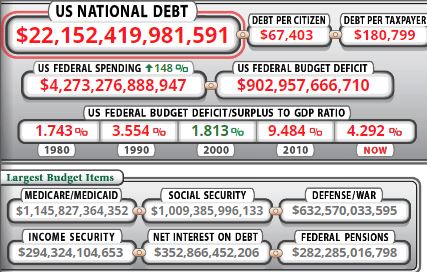by GoldCore
– America’s “debt crisis is coming soon” warns economist Martin Feldstein
– To avoid economic distress, the government has to reduce future entitlement spending
– The most dangerous domestic problem facing America’s federal government is the rapid growth of its budget deficit and national debt

According to the Congressional Budget Office, the deficit this year will be $900 billion, more than 4% of gross domestic product. It will surpass $1 trillion in 2022.
The federal debt is now 78% of GDP. By 2028, it is projected to be nearly 100% of GDP and still rising.
All this will have very serious economic consequences, and the CBO understates the problem. It has to base its projections on current law—in this case, the levels of spending and the future tax rules and rates that appear in law today.
Those levels don’t match realistic predictions.
Current law projects that defense spending will decline as a share of GDP, from a very low 3.1% now to about 2.5% over the next 10 years. None of the military and civilian defense experts with whom I’ve spoken believe that will happen, given America’s global responsibilities and the need to modernize U.S. military equipment. It is likelier that defense spending will stay around 3% of GDP or even increase in the coming decade. And if the outlook for defense spending is increased, the Democratic House majority will insist that the non-defense discretionary spending should rise to match its trajectory.
If defense and other discretionary spending stays steady as a share of GDP, the annual deficit will increase by nearly 1% of GDP—from 4.2% of GDP now to about 5% of GDP 10 years from now. At the same time, the tax increases in current law that the CBO assumes will occur during the next decade as some of the recent cuts are phased out probably won’t happen. Congress will face strong political pressure to avoid a functional tax increase.
What does that mean for the long-run ratio of the federal debt to GDP? Federal debt will probably surpass 100% much sooner than 2028. If discretionary spending increases, debt growth will jump to 100% even quicker. When America’s creditors at home and abroad realize this, they will push up the interest rate the U.S. government pays on its debt. That will mean still more growth in debt. A 1% increase in the interest rate the government pays on its debt would boost the annual deficit by more than 1%. The higher long-run debt-to-GDP ratio would crowd out business investment and substantially reduce the economy’s growth rate. That in turn would mean lower real incomes and less tax revenue, leading to—you guessed it—an even higher debt-to-GDP ratio.
To avoid economic distress, the government either has to impose higher taxes or reduce future spending. Since raising taxes weakens incentives and further slows economic growth—worsening the debt-to-GDP ratio—the better approach is to slow government spending growth. Defense spending and nondefense discretionary outlays can’t be reduced below the unprecedented and dangerously low shares of GDP that the CBO projects.
Thus the only option is to throw the brakes on entitlements.
The simplest approach is to raise the age of eligibility for Social Security, as Congress did in 1983. Bipartisan legislation then voted to postpone “full” benefits from age 65 to 67, allowing earlier benefits at an actuarially reduced level. Because Congress slowly phased the change in over several decades, it avoided any significant political opposition. In the intervening 35 years, the average life expectancy of Americans in their late 60s has risen about three years. It would be appropriate to increase the age of eligibility for full benefits from 67 to 70 and index it to life expectancy. Exceptions could be made for retirees with low lifetime incomes.
Lawmakers don’t like to cut spending, but they have to do something. Otherwise the exploding national debt will be an increasing burden on our children, economic growth and our future standard of living.
By Martin Feldstein in the Wall Street Journal
